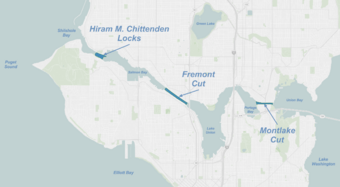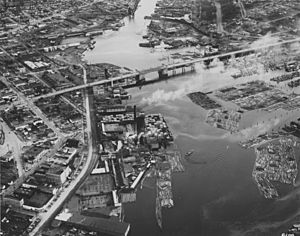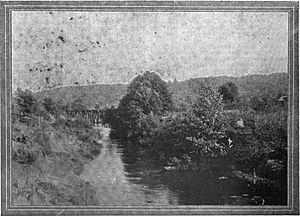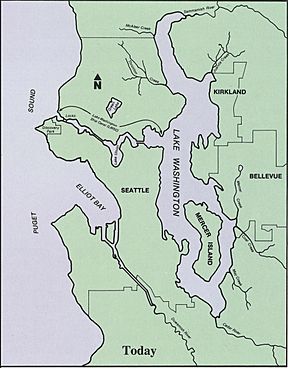Lake Washington Ship Canal facts for kids
Quick facts for kids |
|
|
Chittenden Locks and Lake Washington Ship Canal
|
|
 |
|
| Location | Salmon Bay, Seattle |
|---|---|
| Built | 1911–1934 |
| Architect | Bebb and Gould |
| Architectural style | Late 19th And 20th Century Revivals |
| NRHP reference No. | 78002751 |
| Added to NRHP | December 14, 1978 |
The Lake Washington Ship Canal is a waterway in Seattle, Washington. It connects the fresh water of Lake Washington with the salty water of Puget Sound. The canal has a special set of gates called the Hiram M. Chittenden Locks. These locks help boats move between Lake Washington and Puget Sound, even though the water levels are about 20 feet (6 meters) different.
The canal runs from east to west. It links several bodies of water: Union Bay, the Montlake Cut, Portage Bay, Lake Union, the Fremont Cut, Salmon Bay, and Shilshole Bay, which is part of Puget Sound.
Contents
History of the Canal
The idea for the ship canal started a long time ago, in 1854. People wanted a way to connect Lake Washington to Puget Sound. This would help them move logs, lumber, and fishing boats. The United States Navy even thought about building a naval shipyard on Lake Washington because of the canal idea.
The U.S. Army Corps of Engineers began planning the project in 1891. Construction officially started in 1911 and was finished in 1934. Before the canal was built, water from Lake Washington flowed out through the Black River to the Duwamish River. Because of delays in building the canal, the U.S. Navy built its shipyard in Bremerton, Washington, instead of on Lake Washington.
Early Ideas and Efforts
For hundreds of years, local people would carry their canoes between the lakes. In 1854, a Seattle pioneer named Thomas Mercer suggested building canals to connect Lake Union and Lake Washington to Puget Sound. He also gave the lakes their current names. He called Lake Union that because he hoped the waters would "unite" there. He named Lake Washington after George Washington.
In 1860, a landowner named Harvey L. Pike tried to dig a ditch by himself at Montlake. He wanted to move logs between Portage Bay and Union Bay. He hoped this would make his land more valuable. Later, in 1871, Pike joined with Thomas Burke and Daniel Gilman to form a company. Instead of a canal, they built a tramway to carry coal.
In 1883, David Denny and Burke hired Chinese workers to finish a canal at Montlake. They made a 16-foot (4.9 m) channel with a lock. This allowed logs to float from Lake Washington to Lake Union.
The Army Corps of Engineers looked at Puget Sound for military defense. They thought Lake Washington would be a good place for a Naval base. It had fresh water, coal, and timber nearby. Fresh water was also better for wooden ships. Many different routes for the canal were considered, but the one through Shilshole Bay was eventually chosen.
In 1906, a Seattle developer named James A. Moore suggested building a canal for small ships. It would have two wooden locks connecting Salmon Bay to Shilshole Bay. Moore got permission from Congress for his project.
However, in April 1906, Hiram M. Chittenden became the new Army District Engineer in Seattle. Chittenden liked Moore's chosen route to Shilshole Bay. But he thought Moore's plan was too small and not safe enough. Chittenden believed the locks should be bigger for larger ships. He also thought wooden locks would break down and drain Lake Washington.
Chittenden suggested building a double concrete lock with steel gates instead. This would allow small boats to pass easily. He also wanted just one set of locks at the western end of Salmon Bay. This would lower Lake Washington to the same level as Lake Union. Having only one lock would reduce the risk of flooding and save money. Chittenden worked hard to convince local leaders to support his plan. Even though he had to retire in 1909 due to poor health, he kept working to get Congress to approve the project. The locks were later named after him.

Ballard Locks Construction
Construction of the locks began on November 10, 1911. By July 1912, the locks were closed, making Salmon Bay fresh water. The temporary dam at Montlake was opened in 1916. The Government (or Ballard) Locks officially opened for boat traffic on May 8, 1917. The entire Lake Washington Ship Canal was completed in 1934. In 1956, the locks were renamed in memory of Hiram M. Chittenden.
Canal Crossings


Many bridges and tunnels cross the Lake Washington Ship Canal. From east to west, they are:
- the University Link Tunnel which carries Link Light Rail trains under the canal.
- the Montlake Bridge which carries State Route 513 (Montlake Boulevard NE) over the Montlake Cut.
- the University Bridge which carries Eastlake Avenue over Portage Bay.
- the Ship Canal Bridge which carries Interstate 5 over Portage Bay.
- the George Washington Memorial Bridge (also called the Aurora Bridge) which carries Aurora Avenue N. (State Route 99) over the west end of Lake Union.
- the Fremont Bridge which connects 4th Avenue N. to Fremont Avenue N. over the Fremont Cut.
- the Ballard Bridge which carries 15th Avenue over Salmon Bay.
- a pedestrian crossing only at the Hiram M. Chittenden Locks.
- the BNSF Railway's Salmon Bay Bridge which carries trains over Salmon Bay.
Seattle Landmarks
The Lake Washington Ship Canal and the Hiram M. Chittenden Locks are important historical sites. They are listed on the National Register of Historic Places. The Montlake Cut and the Montlake Bridge are also recognized as City of Seattle Designated Landmarks.




